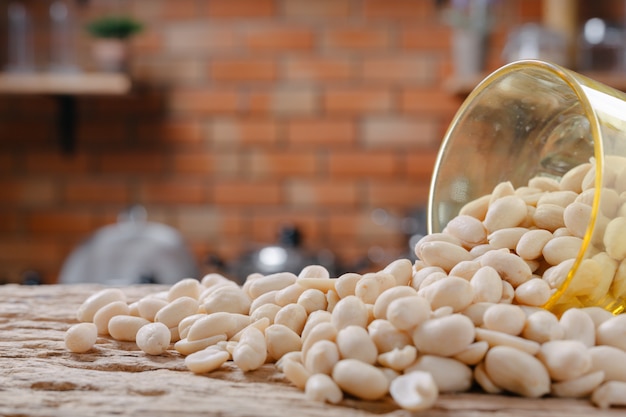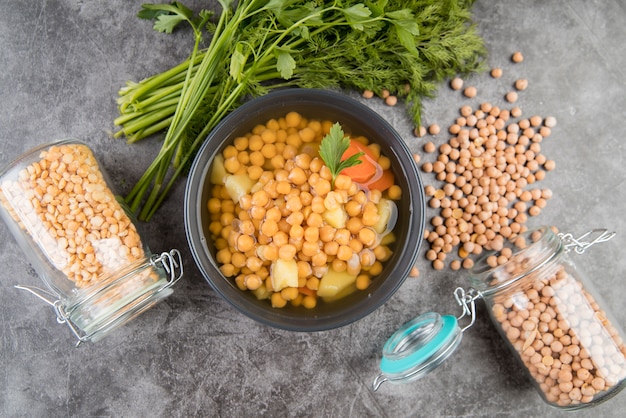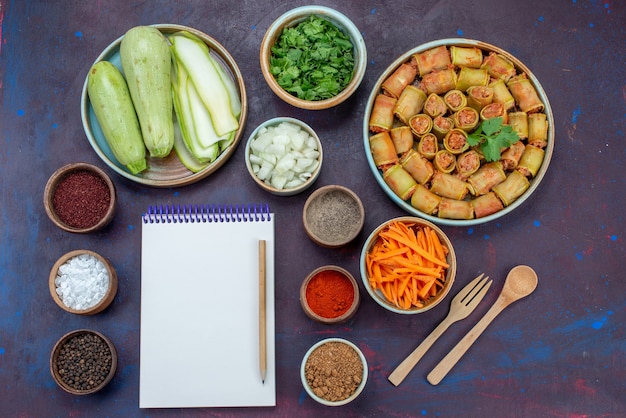Soybeans. Just the word evokes a sense of culinary versatility and healthfulness, doesn't it? And for good reason! As a long-time vegetarian, I've relied on these little powerhouses for years, and they've never let me down. But soybeans are so much more than just tofu or soy milk. They're a gateway to a world of flavors and textures, from creamy dips to hearty stews. So, buckle up, fellow food enthusiasts, because we're about to embark on a culinary adventure that will redefine your perception of this humble bean.
(Part 1) From Field to Fork: The Amazing Journey of Soybeans

Imagine a vast field, bathed in sunshine, where rows upon rows of soybean plants stand tall, their pods bursting with promise. That's where our journey begins. Grown across the globe, these unassuming beans have a fascinating history and an even more exciting future. But what exactly makes them so special? It's the incredible transformation they undergo, morphing from humble beans into a plethora of delicious and nutritious products.
Soybean Products: A Culinary Treasure Trove
Let's start with the superstar of the soybean world: tofu. You probably know it, but do you truly understand its potential? This versatile protein source is simply soybeans that have been ground, cooked, and pressed into blocks. It's a blank canvas, ready to soak up the flavors of your favorite sauces and spices. I've had countless delightful experiences with tofu, from savory stir-fries to creamy dips – it never disappoints.
Then there's soy milk, a plant-based alternative to dairy that's gained immense popularity. It's created by grinding soybeans and adding water, and it's a staple in my kitchen. Beyond its use in coffee and cereal, soy milk shines in desserts, sauces, and even ice cream. It's a testament to the versatility of the humble soybean.
And let's not forget soy sauce, a fermented condiment with a deep, umami flavor that's essential in countless Asian dishes. Its salty, savory notes add depth to stir-fries, soups, and marinades. But soybeans don't stop there. Venture beyond the basics and you'll encounter soy yogurt, a creamy and tangy delight, and miso paste, a fermented soybean product with a complex, earthy flavor. And then there's tempeh, a fermented soybean cake packed with protein and a slightly chewy texture. Each product is a testament to the fascinating diversity that soybeans offer.
(Part 2) Unleashing Creativity: Beyond the Basics of Soybeans

Now that we've explored the world of soybean products, it's time to get creative. We're not just talking about basic recipes here. It's about unlocking the potential of soybeans to create culinary masterpieces.
Tofu: A Culinary Canvas
Tofu is like a blank canvas, begging to be transformed into something delicious. It's a protein source that can be adapted to countless cuisines and cooking styles. Think of pan-frying firm tofu with a sprinkle of ginger and a drizzle of sesame oil, or baking it with a sweet and savory honey-garlic marinade. The possibilities are truly endless.
And let's not forget about tofu's ability to mimic other foods. Have you ever tried making tofu ricotta? It's a delightful surprise, perfect for pasta dishes, lasagna, or even just a simple toast. Just blend silken tofu with nutritional yeast and lemon juice, and you've got yourself a creamy, cheesy delight.
Soy Milk: A Versatile Ingredient
Soy milk isn't just for your morning coffee. It's a versatile ingredient that adds a unique touch to baking. Swap out dairy milk for soy milk in your favorite cookie recipe, and you'll be amazed by the lighter, fluffier texture. You can even make delicious soy milk panna cotta, a creamy, silky dessert that's perfect for a special occasion.
Soy milk is also a brilliant base for sauces and soups. Imagine creamy soups, velvety sauces, and even a decadent soy milk ice cream. It's a testament to how the humble soybean can elevate your culinary creations.
(Part 3) Soybeans: A nutritional powerhouse

It's not just about the taste, folks. Soybeans are nutritional powerhouses, packed with protein, fiber, vitamins, and minerals. They're also a rich source of isoflavones, plant compounds linked to a range of health benefits, including improved heart health and bone density.
The Nutritional Benefits of Soybeans
Let's break down the key benefits:
| Nutrient | Benefits |
|---|---|
| Protein | Essential for building and repairing tissues, supporting a healthy immune system, and promoting satiety. |
| Fiber | Aids in digestion, helps control blood sugar levels, and promotes satiety. |
| Isoflavones | May reduce the risk of heart disease, osteoporosis, and certain cancers. |
| Vitamins and Minerals | Soybeans are a good source of vitamins B, E, and K, as well as minerals like iron, calcium, and magnesium. |
Soybeans and Health
Beyond their individual nutritional components, soybeans have been associated with several health benefits. Diets rich in soy protein may help lower cholesterol levels, contributing to a healthier heart. Some studies suggest that soy may help alleviate menopausal symptoms and reduce the risk of certain cancers. While more research is needed to confirm these findings, the potential benefits of incorporating soybeans into a balanced diet are certainly worth exploring.
(Part 4) Getting Started with Soybeans: A Beginner's Guide
Ready to take the plunge into the world of soybeans? Don't worry, I'm here to guide you through the basics, from choosing the right ingredients to mastering some simple recipes.
Choosing the Right Soy Products
First things first, let's talk about choosing the right soy products. For tofu, look for firm or extra-firm varieties if you plan on stir-frying or grilling. Silken tofu, on the other hand, is perfect for blending or making creamy sauces. When buying soy milk, opt for unsweetened unless you're looking for a sweeter option. And for soy sauce, choose a good quality product that's not overly salty.
Essential kitchen equipment
You don't need a lot of fancy equipment to cook with soybeans. A good quality pan, a cutting board, and a sharp knife are all you really need. If you're feeling adventurous, you can invest in a tofu press to remove excess water from your tofu, but it's not necessary for most recipes.
Simple and Delicious Recipes
Here are a few simple recipes to get you started:
- Basic tofu scramble: Crumble some firm tofu and sauté it in a pan with onions, peppers, and your favorite spices. Add a splash of soy sauce and serve with toast or rice. This is a quick and easy breakfast or lunch option that's packed with protein and flavor.
- Soy Milk Pancakes: Whip up a batch of pancakes using soy milk instead of dairy milk. You can add fruit, nuts, or chocolate chips for a sweet treat. Soy milk pancakes are light, fluffy, and surprisingly delicious.
- Easy Stir-Fry: Combine tofu, vegetables, and a flavorful stir-fry sauce in a pan and cook until everything is tender. Serve over rice or noodles. This is a versatile dish that can be customized with your favorite vegetables and sauces.
(Part 5) Soybeans in Asian Cuisine: A culinary journey
Soybeans play a central role in many Asian cuisines, contributing their unique flavors and textures to countless dishes. Let's embark on a culinary journey through some of these exciting traditions.
The Wonders of Japanese Cuisine
Japan, with its refined culinary techniques, has a special place for soybeans. From the delicate umami of miso soup to the silken texture of edamame, Japanese cuisine showcases the versatility of this humble bean. Miso, a fermented soybean paste, is used to flavor soups, stews, and sauces. Edamame, steamed soybeans, are a popular appetizer and can also be added to stir-fries and salads.
Tofu is also a staple in Japanese cuisine, often featured in dishes like mapo tofu, where it's cooked in a spicy sauce with ground meat and vegetables. And let's not forget about soy sauce, a key ingredient in many Japanese dishes, from sushi to ramen. It's the perfect way to add a touch of umami and saltiness.
Exploring the Flavors of China
In China, soybeans are equally revered. Tofu is a versatile ingredient used in countless dishes, from the famous mapo tofu to the savory tofu stir-fries. Soy sauce, with its rich history, is a fundamental condiment, adding depth to countless recipes. From the spicy Sichuan dishes to the delicate Cantonese cuisine, soy sauce plays a crucial role in bringing out the flavors of the ingredients.
Another notable soybean product in Chinese cuisine is soy milk. It's a popular breakfast drink and is also used in making desserts like tofu pudding and soy milk jelly. It's a testament to the versatility of soybeans in this diverse culinary landscape.
(Part 6) Soybeans in Western Cuisine: A Culinary Revolution
Don't think soybeans are just for Asian dishes. They've been making their way into Western cuisine, revolutionizing the way we cook and eat.
Soybeans in the Vegan World
Soybeans are a staple in the vegan world, providing a great source of protein and other nutrients. From vegan burgers to tofu steaks, soybeans are helping to create meat-free dishes that are delicious and satisfying. Soy cheese, a plant-based alternative to dairy cheese, is another popular option, adding a creamy texture to sandwiches, pizzas, and pasta dishes.
The Rise of Soy-Based Meat Alternatives
Soy-based meat alternatives are gaining popularity, and for good reason. They're a great way to reduce your meat consumption and contribute to a more sustainable food system. Soy protein is used to create meatless patties, sausages, and even chicken nuggets that mimic the taste and texture of their meat counterparts. You'll find these products at most supermarkets these days, making it easier than ever to experiment with meat-free meals.
(Part 7) Soybeans: A Sustainable Future for Food
Soybeans are more than just a culinary trend. They're at the forefront of the future of food, offering sustainable and healthy solutions for a growing global population.
Sustainability and Soybeans
Soybeans are a relatively efficient crop, requiring less water and land than other protein sources. They also have the potential to be a source of biofuels, helping to reduce our reliance on fossil fuels. However, it's important to be aware of the environmental impact of soy production, particularly in terms of deforestation and land use.
By choosing sustainably sourced soy products, we can support responsible farming practices and ensure a healthy future for both people and the planet. Look for labels that indicate sustainable sourcing, such as the "Roundtable on Sustainable Soy" certification.
Soybeans and Food Security
Soybeans are a valuable source of protein and nutrients, playing a vital role in ensuring global food security. As the world's population continues to grow, soybeans will become even more important in providing affordable and nutritious food for everyone. By promoting sustainable soy production and distribution, we can help ensure that everyone has access to the food they need.
(Part 8) Soybeans: A Culinary Adventure
From the humble bean to the countless dishes it graces, soybeans have taken us on a culinary adventure. We've explored their unique flavors and textures, their nutritional benefits, and their role in the future of food. As we've learned, soybeans are more than just a simple ingredient. They're a source of inspiration, a symbol of culinary creativity, and a key to a healthier and more sustainable future.
So, get out there, experiment, and embrace the versatility of soybeans. You might just discover your next culinary obsession!
FAQs
- What are the different types of soy products?
The world of soybeans is diverse! You'll find a range of products, including tofu, soy milk, soy sauce, tempeh, edamame, miso paste, and soy yogurt. Each product has its unique flavor and texture, and can be used in a variety of dishes.
- Are soybeans good for you?
Absolutely! Soybeans are a great source of protein, fiber, vitamins, and minerals. They're also packed with isoflavones, which have been linked to a number of health benefits. They're a fantastic addition to a balanced diet.
- How do I cook tofu?
Tofu is incredibly versatile. You can pan-fry, bake, grill, or steam it. You can even use it in smoothies, dips, and sauces. The key is to press out excess water from the tofu before cooking, which will give it a firmer texture and prevent it from becoming soggy.
- What are some good recipes for soybeans?
The possibilities are endless! There are countless recipes for soybeans, from simple tofu scrambles to complex stir-fries. You can find many delicious recipes online or in cookbooks. Don't be afraid to experiment and find your own favorite dishes.
- What is the environmental impact of soy production?
Soy production can have a significant environmental impact, particularly in terms of deforestation and land use. However, by choosing sustainably sourced soy products, we can support responsible farming practices and ensure a healthy future for both people and the planet. Look for labels that indicate sustainable sourcing, such as the "Roundtable on Sustainable Soy" certification.
Everyone is watching

How to Cook Frozen Lobster Tails Perfectly: A Step-by-Step Guide
RecipesLobster. Just the word conjures up images of lavish meals, special occasions, and a taste of luxury. But let's...

Pigs in a Blanket Cooking Time: How Long to Bake for Perfect Results
RecipesAh, pigs in a blanket. Just the name conjures up images of those delightful little parcels of crispy pastry en...

Pork Fillet Cooking Time: How Long to Cook It Perfectly
RecipesPork fillet, or tenderloin as it's sometimes called, is a real favourite in our house. It's so versatile, and...

The Ultimate Guide to Tender, Juicy Pulled Pork
RecipesRight, let's talk pulled pork. It's one of those dishes that just screams "comfort food," doesn't it? I mean...

The Ultimate Guide to Cooking Sweet Potatoes: From Roasting to Mashing
RecipesSweet potatoes. Just the name conjures up images of warm, comforting dishes, bursts of vibrant color, and a to...
